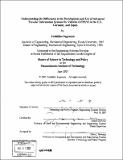Understanding the differences in the development and use of advanced traveler information systems for vehicles (ATIS/V) in the U.S., Germany, and Japan
Author(s)
Sugawara, Yoshihiko
DownloadFull printable version (11.20Mb)
Other Contributors
Massachusetts Institute of Technology. Technology and Policy Program.
Advisor
Joseph Sussman.
Terms of use
Metadata
Show full item recordAbstract
Traffic congestion is becoming a serious problem. As a solution, advanced traveler information systems (ATIS) mitigate traffic congestion by providing real-time traffic information to travelers. ATIS includes various applications such as radio traffic reporting services and websites. Among those, this thesis focuses on more advanced real-time traffic information systems, which provide sophisticated traffic information to drivers via in-vehicle devices such as car navigation systems: we call them ATISN (advanced traveler information systems for vehicles). ATISN has a high potential to mitigate traffic congestion and improve travel for individual drivers. However, in some countries, ATISN has not been accepted well by drivers. To improve this situation, three questions motivate this study: (1) why does ATISN in some parts of the world have more penetration than in others, (2) what can be done to increase the penetration of ATISN, and (3) what kinds of strategic alliances among stakeholders can help to make better ATISNs. This thesis compares three countries, the U.S., Germany, and Japan, by a qualitative analysis of the system dynamics methodology to clarify reasons which have been causing differences in the penetration. (cont.) Additionally, a new supply chain model based on McQueen's model is used. Furthermore, stakeholder analysis and case studies regarding stakeholder alliances in current ATISNs and highway service operators' strategies for alliances are conducted. In conclusion, from a macro-perspective analysis, many prominent factors in the dynamics of ATISN penetration are found, such as public investment in a public-driven ATISN, the in-vehicle device market, and two-way communication technology development. Furthermore, from analysis for alliances among stakeholders, no absolute best alliances but many possibilities to create alliances for ATISN are clarified, and the use of ATISN as a differentiation tool is suggested as one option worth considering.
Description
Thesis (S.M.)--Massachusetts Institute of Technology, Engineering Systems Division, Technology and Policy Program, 2007. Includes bibliographical references (p. 143-157).
Date issued
2007Department
Massachusetts Institute of Technology. Engineering Systems Division; Technology and Policy ProgramPublisher
Massachusetts Institute of Technology
Keywords
Technology and Policy Program.